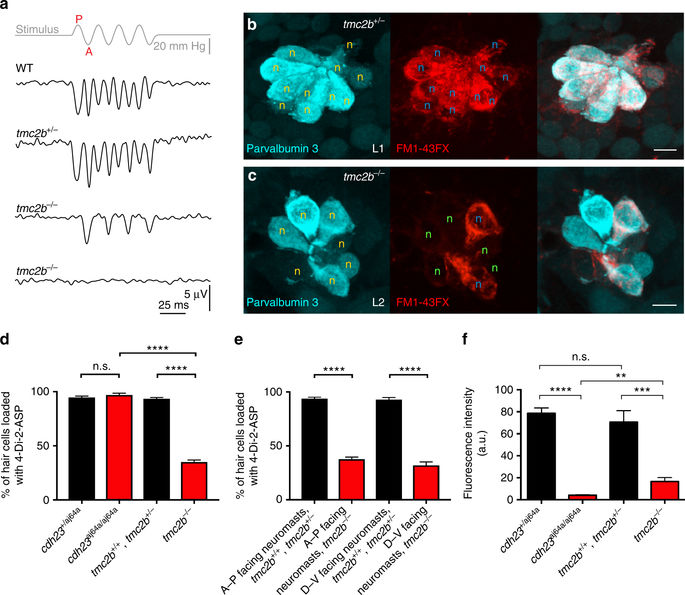Fig. 3
Variable dependence on Tmc2b for mechanotransduction in posterior neuromast hair cells. a Extracellular recordings of microphonic potentials measured from posterior neuromasts with A-P orientations of 6-dpf zebrafish larvae are displayed. The responses in tmc2b ?/? are often absent, bottom trace (n?=?9/15); however, several responses (n?=?6/15) are highly asymmetric, with weakened amplitude for one direction of stimulus and no response for the other direction, penultimate trace. Deflection anteriorly (A) or posteriorly (P). b, c Qualitative confocal images of hair cells labeled with FM1-43FX (red), to assess mechanotransduction function, and parvalbumin 3 (cyan)50, as a counter label, to visualize mature hair cells. b A posterior neuromast from a tmc2b +/? animal demonstrates co-labeling of all hair cells. c In a tmc2b ?/? animal, a posterior neuromast contains hair cells that label with FM1-43FX and a subset that do not (label:no label; 2:5). Orange n, hair cells labeled with parvalbumin 3 antiserum. Blue n, hair cells that load with FM1-43FX. Green n, hair cells that do not load. Scale bar?=?5??m. d, e Percentages of hair cells within PLL neuromasts that label with 4-Di-2-ASP. d In neuromasts of tmc2b +/+ and tmc2b +/? animals, most hair cells take up fluorophore. Approximately 35% of hair cells in each PLL neuromast of tmc2b ?/? fish take up 4-Di-2-ASP. In contrast, in cdh23 aj64a/aj64a mutants, all hair cells take up dye, though at much lower quantities than wild-type animals (see f and Supplementary Fig. 4b). **** Kruskal?Wallis test P value?<?0.0001. n values???20. e In mutants, A?P-facing and D?V-facing posterior neuromasts have similar percentages of hair cells that gather fluorophore, ~38 and 32%, respectively. ****Student?s t-test P value?<?0.0001. n values???23. f Mean fluorescence intensity of 4-Di-2-ASP uptake of the brightest cell per neuromast. n values???17. Kruskal?Wallis test ****P?<?0.0001, ***P?=?0.001, **P?=?0.0215

